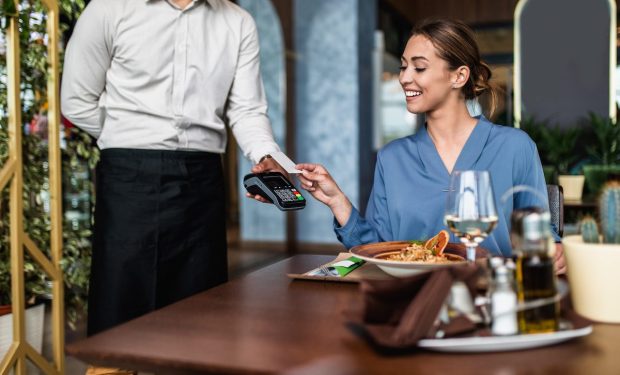More Restaurant Customers Want and Expect Tableside Payments

As technology takes over the restaurant industry, even full-service restaurants (FSRs) are facing increasing consumer expectations of digital efficiency.
Chris Simms, founder and CEO of casual dining chain Lazy Dog Restaurant and Bar, which has more than 40 locations across eight states, noted in an interview with PYMNTS that mobile payments are quickly becoming the norm.
“Tap-to-pay and text-to-pay [are key] — we’re already using both of those now, which is fantastic, as people are less and less willing to give up their credit card [and as] a lot of that payment is going onto their phone via Google Wallet and Apple Pay,” Simms said. “I think that will take more and more precedence as we look forward: making sure that we have the ability to easily take those payments.”
He added that since the company has been using CardFree’s mobile payment technology, he has been surprised by customers’ comfort with and amenability to the system, a consequence of diners’ desire to “control their exit” rather than waiting around to get their card back.
Granted, dine-in customers are split on the role of technology in the restaurant, according to research from the May/June edition of PYMNTS’ Digital Divide study, The Digital Divide: Technology, the Metaverse and the Future of Dining Out, which drew from a survey of nearly 2,500 United States consumers. For instance, 51% of grab-and-go customers said that viewing a menu with a QR code has a positive impact on their satisfaction, while only 26% of dine-in customers said the same.
Many restaurants have been scaling back their tech offerings in the aftermath of the peak of the pandemic. Research from the 2022 edition of PYMNTS’ Restaurant Readiness Index found that, in April, 73% offered digital wallet capabilities, down from 81% in September 2021.
Yet, it seems that while higher-end FSRs may indeed require more face-to-face service and less self-service technology, casual dining restaurants may be expected to find a balance between the two.
“We don’t want to have technology take the place of the hospitality, but instead our goal is to actually have the technology enhance the hospitality,” Simms said.
He noted that while options such as tap-and-pay may improve the experience, self-service tablets are taking it too far, getting in the way of the person-to-person connection that can occur at an FSR when the customers are waited on.
Much as data-informed personalization is becoming a priority for quick-service restaurants (QSRs) and fast-casual brands when it comes to driving digital engagement, Simms said he sees consumer data also playing a greater role in the casual dining experience going forward. If waitstaff can access insights about customers’ preferences before they arrive at the table, they can provide better service.
“It’s always nice to be able to cater to a guest based on what they may have ordered in the past,” Simms said. “Not to say we’re there today, but that could be something that would be helpful to the servers [down the line].”